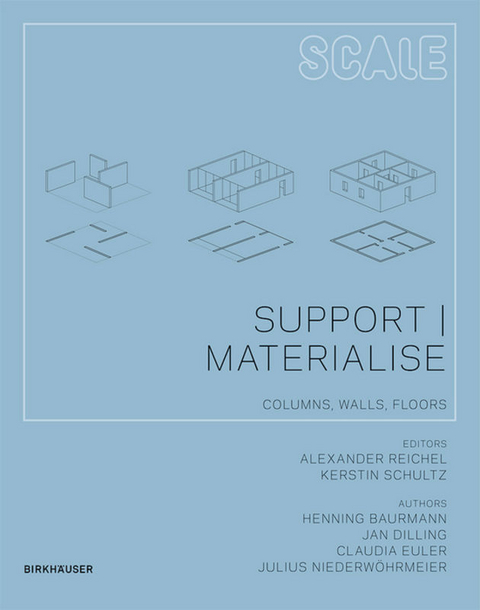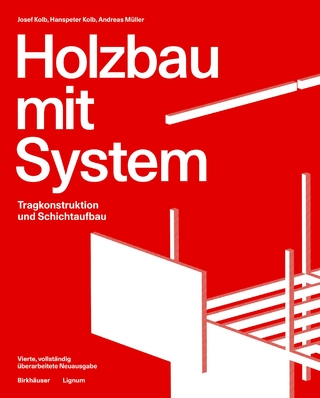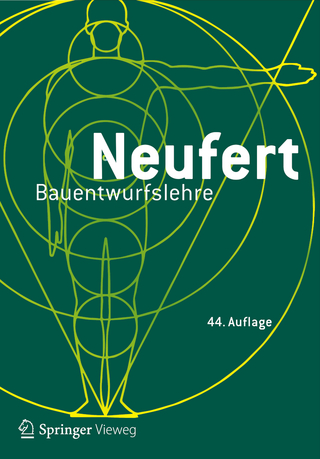
Support I Materialise
Birkhäuser Verlag GmbH
978-3-0346-0040-8 (ISBN)
Alexander Reichel, Reichel Architekten BDA, Kassel; Kerstin Schultz, liquid architekten, Hochschule Darmstadt.
Chapter 1 Introduction
1.1. Introduction to the subject
- The cultural history of load-bearing structures
- Prospects, visions (mega-structures, flexible structures, dismantling/reconstruction, new materials)
1.2 Building site
- regional, topographical features (climate, surroundings, neighbourhood)
1.3 Building
Which load-bearing structure is suitable for which purposes: scale and uses: hall buildings, housing construction, office construction?
1.4 The design quality of bearing structures
The difference between visible and non-visible bearing structures
1.5 Bearing structures
- Overview of bearing structures: from linear (shell) to two-dimensional (wall, ceiling) structures
- Principles underlying bearing structures - foundations, support, bracing
- Components - support, wall, ceiling
1.6 Static systems
- Criteria favouring a specific bearing structure: advantages and disadvantages
- shell construction (cross-wall structures?), slab construction, hall building, space frames, shells, hybrid structures, tensile structures, membranes / foils / textiles
1.7 Demands placed on material properties
- Transfer of tensile forces, pressure, bending stress
- Spans, apertures, maximum sizes
- Deflexion, jointing [Fugen]/grooves [Nuten]??
- Preservation of structures (fire protection, soundproofing, etc.)
- Integration of services
1.8 Sustainability
- Use, extension, (general definitions)
- Maintenance, servicing, longevity, extension/addition, conversion/new use, disassembly, dismantling, recycling
- Manufacture + waste disposal, environmental compatibility (general definitions, comparison of building materials)
Primary energy requirement, use of resources, damage to environment by harmful substances, life cycle
- Cost effectiveness and costs (general definitions, building materials / comparison of bearing systems)
- Production costs
2nd Chapter Structural types
2.1. Wall construction (including cross-wall construction and slab construction)
Presentation of bearing systems (loads, bearing structures, bracing)
- Walls (focus on load-bearing walls; difference to non-bearing walls)
- Ceilings, main beams, suspender beams
Realisation (as relating to the walls and ceilings?)
Masonry (bricks, concrete blocks...)
- Reinforced concrete
- Connections/drawings
- (Connection of the individual elements, layer structure, connections, wall floor ceiling, each between the same and different materials???
2.2 Shell structures (including half-timber structures)
- Bearing systems (loads, bearing structures, bracing)
- Building elements, function/role: supports, reinforcing elements (core, ceilings, walls, cables...), girders (including truss girders in this case), in-fills between the building elements, walls and ceilings
Realisation: Steel, reinforced concrete, wood
- Connections/drawings: Joining of individual parts, layered construction, connections, wall floor ceiling, each between the same and different materials???
2.3 Special forms
- Hybrid (definition of a hybrid here: Combination of different support systems - distinguished from combinations of materials that act as bearing elements, e.g. Reinforced concrete, structural wood building...)
- shell construction
- a hall building
- space frames
- cable-net
- membranes
- bridges
3rd Chapter Examples (8-10 Projects)
- Shell construction: reinforced concrete, wood, steel
- Wall construction method: reinforced concrete, masonry, cross-wall construction
4. Chapter Appendix
- References to standards and guidelines (selection)
- Associations
- Links
- Secondary literature
- Tables
- Manufacturers
- Photo credits/acknowledgements
| Erscheint lt. Verlag | 17.10.2013 |
|---|---|
| Reihe/Serie | Scale ; 3 |
| Zusatzinfo | 100 b/w and 150 col. ill. |
| Verlagsort | Basel/Berlin/Boston |
| Sprache | englisch |
| Maße | 220 x 280 mm |
| Gewicht | 762 g |
| Themenwelt | Technik ► Architektur |
| Schlagworte | Baukonstruktion • bearing structure • concrete construction • Construction • construction design • crosswall construction • Design • frame construcion • Hardcover, Softcover / Kunst/Architektur • Masonry Construction • panel construction • post and beam construction • Prefabrication • slab construction • Solid construction • Support • timber bearing structure • Timber Construction • Tragwerke • Vorfertigung (Bau) |
| ISBN-10 | 3-0346-0040-2 / 3034600402 |
| ISBN-13 | 978-3-0346-0040-8 / 9783034600408 |
| Zustand | Neuware |
| Haben Sie eine Frage zum Produkt? |
aus dem Bereich


